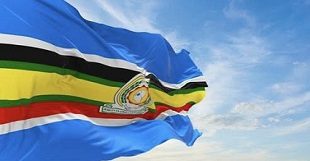
Book Review: David Sseppuyya on ‘Why no prosperity in Africa?’
Title: Africa’s Industrialization & Prosperity: From Esau Syndrome to Structural Adjustment
Author: David Ssepuuya
Publisher: Mwesigwa Foundation
Available: Leading Bookstores
Why is Africa, which is always said to be so endowed with natural resources, so poor?
In a new book titled “Africa’s Industrialization & Prosperity: From Esau Syndrome to Structural Adjustment Strategy,” renowned Ugandan journalist and editor David Ssepuuya combines personal anecdotes from several African countries with research and data from institutions like the World Bank, to show his concern that the occasional bubbles of growth on the continent never morph into prosperity. He asks `why the disconnect?’ and proceeds to give his answer on 400-pages broken into 18 chapters.
Ssepuuya’s journalistic emphasis on evidence, citations, timeliness, seen in his use of the latest statistics and verifiable anecdotes, gives authoritativeness to a book packed with views that would otherwise attract skepticism.
The `Esau Syndrome’ is a Biblical allusion and the return to structural adjustment programmes comes from Ssepuuya’s stints with the World Bank and IMF. He also cites the views of known names like Christine Malmberg Calvo, Akiki Mujaju, Phareas Mutibwa, Jeffery Sachs, Theodore Schultz, Sir Arthur Lewis, and Raphael Kaplinsky, numerous other professors, books, and research papers on the subject.
Ssepuuya bases his conclusions on real-life experiences, reading, and travel rather than academic theories.On page 162, for example, he writes about his tour of Japan in 1999 where he visited the cenotaph of Hiroshima, erected in memory of thousands who died when America dropped an atomic bomb on the city in 1945.
The section, titled `A dragon among lion cubs’, tackles a common theme: China’s impact on Africa’s development and this was shortly before the first Forum on China African Cooperation (FOCAC) in Beijing. Ssepuuya uses it to spin a tale about a three-horse race to modernity between Japan, China, and Africa that starts in the late 19th century, when Japan was an imperial power, China its impoverished backwater, and Africa was being colonised. The force of interplay between Ssepuuya’s aspirations for Africa and his full awareness of the reality is revealed again in the poignant personal connection he has with one of history’s ugliest moments.
He writes that as he stood before the cenotaph of Hiroshima, he realised that: “The uranium which made the atomic bomb- two actually for the other was dropped on the city of Nagasaki, a little farther south – was sourced from a mine not far from my birthplace. The Shinkolobwe mine in south-eastern Congo is on the same Congo craton as Kilembe Mines, where my father worked in the mid-western Uganda town at the foot of the Rwenzori Mountains”.
In this Chapter, as in most of the book, Ssepuuya reveals his worst frustration about Africa’s failure to industrialise. He shows it as a result of history; slave trade and colonialism, and of the Esau Syndrome – the tendency of Africa’s corrupt leaders to give away the continent’s valuable resources for short-term gain.
To describe Africa’s relationship with its latest conqueror; China, Ssepuuya rephrases a statement the historian; Ian Morris, made about China when it still played second fiddle to Japan.
Morris wrote that: “Japan lacked resources; China had plenty. Japan needed markets; China was full of them.”
Now, Ssepuuya writes: “An industrialising China needs resources, Africa has plenty. An industrialising China needs markets, Africa is full of them”.
Ssepuuya is bold even in instances where he is not original. In a 5-step route of Africa on the move illustrated on the book cover, he prioritizes job-rich sub-sectors and backing them with subsidies, cheap financing, infrastructure, and efficient bureaucracies. It is a public-private-project model borrowed from the McKinsey Global Institute’s famous 2012 report entitled `Africa at work: Job creation and inclusive growth.”
Ssepuuya, however, detours off the beaten path even when borrowing ideas. For example, McKinsey are strong advocates of tapping into agriculture’s job-creating potential but Ssepuuya is dismissive of anything agro. He uses another study, this time by Margaret S. McMillan and Kenneth Hartgen, which shows that although agriculture and trade have the lowest mean productivity, up to 75% of economically active Africans are engaged in those two sectors. Ssepuuya says this archaic situation requires immediate and urgent attention since agriculture and trade are humanity’s oldest economic activities.
“This implies that the structure of African economic activity is largely unchanged over centuries,” he writes, “this should be alarming enough to compel policy changes at all levels.”
“Government planners will need to be freed from the limitations of agro-focus,” he writes. According to him, agro-focus runs counter to the urgent need to diversify the bases of economies and concentrates resources in the least productive sector of the economy.
“The agro-mentality in Africa has also reinforced the deceptive concept of comparative advantage, which locks nations; particularly poor African countries, in low value economic activities.”
“The agro-instinct is a bug that bites all across the continent,” he writes and adds that “it is residual”. He dismissively uses the example of former Vice President Gilbert Bukenya who, in spite of being a distinguished professor of medicine, retired into agriculture and former Gambia president YahyaJammeh, who haboured similar ambitions until, he was sent packing.
“No lecture circuits for these people; no research offers. They came from the land… to that they will return.”
Some readers might find the chatty style applied to the hard topics appealing but a few might wish for more formality. In any case, the clear Uganda-centrist orientation of the book might limit its otherwise global appeal.
Talking about Toro King Oyo Nyimba Iguru IV as the object of “city-slicker marriage-hopefuls (and possibly as many village damsels)” might connect locally but bomb elsewhere. His choice of Africa’s saviours reveals Ssepuuya’s vision.
His favourite people on this mission are thinkers, strategists, and globally-aware technocrats. But, if getting Africa industrialised is hard, pushing African politicians from the driving seat of development; as Ssepuuya’s book attempts to do, will be even harder.
 The Independent Uganda: You get the Truth we Pay the Price
The Independent Uganda: You get the Truth we Pay the Price


